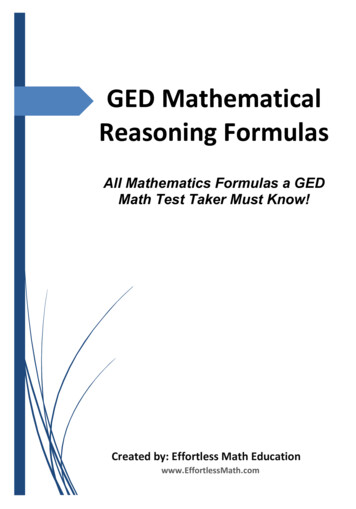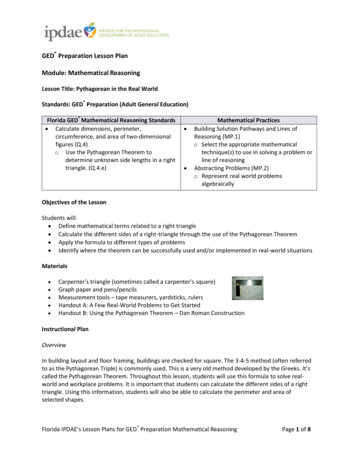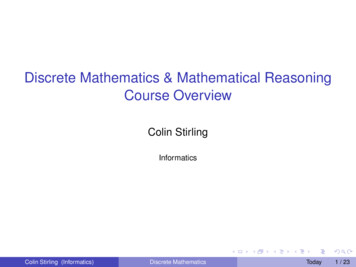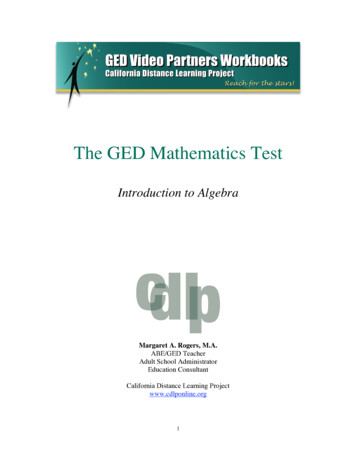
Transcription
GED MathematicalReasoning FormulasAll Mathematics Formulas a GEDMath Test Taker Must Know!Created by: Effortless Math Educationwww.EffortlessMath.com
GED Mathematical Reasoning FormulasTaking the GED with only a few weeks or even few days to study?First and foremost, you should understand that the 2019 GED Mathematical Reasoningtest contains a formula sheet, which displays formulas relating to geometricmeasurement and certain algebra concepts. Formulas are provided to test-takers sothat they may focus on application, rather than the memorization, of formulas.However, the test does not provide a list of all basic formulas that will be required toknow for the test. This means that you will need to be able to recall many mathformulas on the GED.Below you will find the 2019 GED Mathematics Formula Sheet followed by a completelist of all Math formulas you MUST have learned before test day, as well as someexplanations for how to use them and what they mean. Keep this list around for a quickreminder when you forget one of the formulas.Review them all, then take a look at the math topics to begin applying them!Good luck!www.EffortlessMath.com1
GED Mathematical Reasoning FormulasGED Mathematical Reasoning Formula SheetArea of a:𝐴 𝑠2𝐴 𝑙𝑤𝐴 𝑏ℎ1𝐴 𝑏ℎ21𝐴 ℎ(𝑏1 𝑏2 cleSurface Area and Volume of a:Rectangular𝑆𝐴 2𝑙𝑤 2𝑙ℎ 2𝑤ℎ𝑉 𝑙𝑤ℎRight Prism𝑆𝐴 𝑝ℎ 2𝐵𝑉 𝐵ℎCylinder𝑆𝐴 2𝜋𝑟ℎ 2𝜋𝑟 2𝑉 𝜋𝑟 2 ℎPyramid1𝑆𝐴 𝑝𝑠 𝐵2𝑆𝐴 𝜋𝑟 𝜋𝑟 21𝑉 𝐵ℎ31𝑉 𝜋𝑟 2 ℎ34𝑆𝐴 4𝜋𝑟 2𝑉 𝜋𝑟 33(𝑝 perimeter of base 𝐵; 𝜋 3.14)ConeSphereAlgebraSlope-intercept form of the equation of a line𝑦2 𝑦1𝑥2 𝑥1𝑦 𝑚𝑥 𝑏Point-slope form of the Equation of a line𝑦 𝑦1 𝑚(𝑥 𝑥1 )Standard form of a Quadratic equation𝑦 𝑎𝑥 2 𝑏𝑥 𝑐Slope of a lineQuadratic formulaPythagorean theoremSimple interestwww.EffortlessMath.com𝑚 𝑏 𝑏 2 4𝑎𝑐2𝑎𝑎2 𝑏 2 𝑐 2𝑥 𝐼 𝑝𝑟𝑡(𝐼 interest, 𝑝 principal, 𝑟 rate, 𝑡 time)2
GED Mathematical Reasoning FormulasA Quick Review and the List of all GED MathematicsFormulasPlace ValueFractions𝑎The value of the place, or position, A number expressed in the form 𝑏of a digit in a number.Adding and Subtracting with theExample: In 456, the 5 is in “tens” same denominator:𝑎𝑐𝑎 𝑐position.Comparing Numbers SignsEqual to Less than Greater than Greater than or equal Less than or equal RoundingPutting a number up or down to thenearest whole number or thenearest hundred, etc.Example: 64 rounded to the nearestten is 60, because 64 is closer to 60than to 70.Whole NumberThe numbers {0, 1, 2, 3, }𝑏𝑎𝑏 𝑏𝑏𝑐𝑎 𝑐𝑏𝑏 Adding and Subtracting with thedifferent denominator:𝑎𝑏𝑎𝑏𝑐𝑎𝑑 𝑐𝑏𝑑𝑏𝑑𝑐𝑎𝑑 𝑐𝑏𝑑𝑏𝑑 Multiplying and Dividing Fractions:𝑎𝑏𝑎𝑏𝑐𝑎 𝑐𝑑𝑏 d 𝑐 𝑑𝑎𝑏𝑐𝑑 𝑎𝑑𝑏𝑐Mixed NumbersA number composed of a wholeEstimatesFind a number close to the exact number and fraction2answer.Example: 23Converting between improperDecimalsIs a fraction written in a special fractions and mixed numbers:form. For example, instead of a 𝑐 a 𝑐 𝑎𝑏 𝑐𝑏𝑏𝑏1writing you can write 0.5.2Factoring NumbersFactor a number means to break itup into numbers that can bemultiplied together to get theoriginal number.Example: 12 2 2 3www.EffortlessMath.comDivisibility RulesDivisibility means that you are ableto divide a number evenly.Example: 24 is divisible by 6,because 24 6 43
GED Mathematical Reasoning FormulasGreatest Common FactorMultiply common prime factorsExample: 200 2 2 2 5 560 2 2 3 5GCF (200, 60) 2 2 5 20Least Common MultipleCheck multiples of the largestnumberExample: LCM (200, 60): 200 (no),400 (no), 600 (yes!)Integers{ , 3, 2, 1, 0, 1, 2, 3, }Includes: zero, counting numbers,and the negative of the countingnumbersReal NumbersAll numbers that are on numberline. Integers plus fractions,decimals, and irrationals( 2, 3, 𝜋, etc.)Order of OperationsPEMDAS(parentheses / exponents /multiply / divide / add / subtract)Absolute ValueRefers to the distance of a numberfrom 0, the distances are positiveas absolute value of a numbercannot be negative. 22 22RatiosA ratio is a comparison of twonumbers by division.Example: 3: 5, or35Percentagesuse the following formula to findpart, whole, or percentpercent𝑝𝑎𝑟𝑡 100 𝑤ℎ𝑜𝑙𝑒𝑂𝑙𝑑 𝑉𝑎𝑙𝑢𝑒𝑓𝑜𝑟 𝑥 0 𝑥 𝑛 𝑛 𝑥 𝑛 𝑥 𝑛 𝑥 𝑛 or 𝑥 𝑛Proportional RatiosA proportion means that two ratiosare equal. It can be written in twoways:𝑎𝑏Percent of Change𝑁𝑒𝑤 𝑉𝑎𝑙𝑢𝑒 𝑂𝑙𝑑 𝑉𝑎𝑙𝑢𝑒𝑥 𝑥 { 𝑥 𝑓𝑜𝑟 𝑥 0 𝑐𝑑, 𝑎: 𝑏 𝑐: 𝑑 100%DiscountMultiply the regular price by therate of discountSelling price original price – discountExpressions and VariablesTaxA variable is a letter that represents To find tax, multiply the tax rate tounspecified numbers. One may use the taxable amount (income,a variable in the same manner as all property value, etc.)other numbers:MarkupMarkup selling price – costMarkup rate markup divided bythe costwww.EffortlessMath.com4
GED Mathematical Reasoning FormulasAddition2 𝑎 2 plus 𝑎Subtraction𝑦– 34𝑥5𝑎DivisionMultiplication𝑦 minus 34 dividedby 𝑥5 times 𝑎Distributive Property𝑎(𝑏 𝑐) 𝑎𝑏 𝑎𝑐Polynomial𝑃(𝑥) 𝑎0 𝑥 𝑛 𝑎1 𝑥 𝑛 1 𝑎𝑛 2 𝑥 2 𝑎𝑛 1 𝑥 𝑎𝑛Systems of EquationsTwo or more equations working 2𝑥 2𝑦 4together. example: { 2𝑥 𝑦 3EquationsThe values of two mathematicalexpressions are equal.𝑎𝑥 𝑏 𝑐InequalitiesSays that two values are not equalSolving Systems ofEquations by SubstitutionConsider the system ofequations𝑥 𝑦 1, 2𝑥 𝑦 6Substitute 𝑥 1 𝑦 in thesecond equation 2(1 𝑦) 𝑦 5𝑦 2Substitute 𝑦 2 in 𝑥 1 𝑦𝑥 1 2 3𝑎𝑎𝑎𝑎𝑎 𝑏 𝑏 𝑏 𝑏 𝑏a not equal to ba less than ba greater than ba greater than or equal ba less than or equal bLines (Linear Functions)Consider the line that goes throughpoints 𝐴(𝑥1 , 𝑦1 ) and 𝐵(𝑥2 , 𝑦2 ).Distance from 𝑨(𝑥1 , 𝑦1 ) to𝑩(𝑥2 , 𝑦2 ): (𝑥1 𝑥2 )2 (𝑦1 𝑦2 )2Mid-point of the segment AB:M(𝑥1 𝑥2 𝑦1 𝑦22Slope of the line:𝑦2 𝑦1𝑥2 𝑥1www.EffortlessMath.com, 2)𝑟𝑖𝑠𝑒runSolving Systems ofEquations by EliminationExample:𝑥 2𝑦 6 𝑥 𝑦 33𝑦 9𝑦 3𝑥 6 6𝑥 05
GED Mathematical Reasoning FormulasPoint-slope form:Given the slope m and apoint (𝑥1 , 𝑦1 ) on the line, theequation of the line is(𝑦 𝑦1 ) 𝑚(𝑥 𝑥1 ).Slope-intercept form: giventhe slope m and the yintercept 𝑏, then theequation of the line is:Parallel linesHave equal slopes.Perpendicular lines (i.e., thosethat make a 90 angle wherethey intersect) have negativereciprocal slopes:𝑚1 . 𝑚2 1.𝑦 𝑚𝑥 𝑏.Scientific NotationIntersecting LinesIt is a way of expressing numbers thatParallel Lines (l ‖m)are too big or too small to beconveniently written in decimal form.Intersecting lines: oppositeIn scientific notation all numbers are angles are equal. Also, each pairwritten in this form: 𝑚 10𝑛of angles along the same lineadd to 180 . In the figureDecimalScientific notationabove, 𝑎 𝑏 180 .notation5 25,0000.52,122.4565 100 2.5 1045 10 12,122456 103ExponentsRefers to the number of times anumber is multiplied by itself.8 2 2 2 23www.EffortlessMath.comParallel lines: eight angles areformed when a line crosses twoparallel lines. The four bigangles (𝑎) are equal, and thefour small angles (𝑏) are equal.Factoring“FOIL”(𝑥 𝑎)(𝑥 𝑏) 𝑥 2 (𝑏 𝑎)𝑥 𝑎𝑏6
GED Mathematical Reasoning FormulasSquareThe number we get after multiplyingan integer (not a fraction) by itself.Example: 2 2 4, 22 4Square RootsA square root of 𝑥 is a number rwhose square is 𝑥 : 𝑟 2 𝑥𝑟 is a square root of 𝑥Pythagorean Theorem𝑎2 𝑏 2 𝑐 2TrianglesRight triangles:𝑐𝑏𝑎60 30 𝑥 345 45 www.EffortlessMath.com𝑥“Difference of Squares”𝑎2 𝑏 2 (𝑎 𝑏)(𝑎 𝑏)𝑎2 2𝑎𝑏 𝑏 2 (𝑎 𝑏)(𝑎 𝑏)𝑎2 2𝑎𝑏 𝑏 2 (𝑎 𝑏)(𝑎 𝑏)“Reverse FOIL”𝑥 2 (𝑏 𝑎)𝑥 𝑎𝑏 (𝑥 𝑎)(𝑥 𝑏)You can use Reverse FOIL to factor apolynomial by thinking about twonumbers a and b which add to thenumber in front of the 𝑥, and whichmultiply to give the constant. Forexample, to factor 𝑥 2 5𝑥 6, thenumbers add to 5 and multiply to 6,i.e.:𝑎 2 and 𝑏 3, so that𝑥 2 5𝑥 6 (𝑥 2)(𝑥 3).To solve a quadratic such as𝑥 2 𝑏𝑥 𝑐 0, first factor the leftside to get (𝑥 𝑎)(𝑥 𝑏) 0, thenset each part in parentheses equal tozero. For example, 𝑥 2 4𝑥 3 (𝑥 3)(𝑥 1) 0 so that 𝑥 3or 𝑥 1.To solve two linear equations in x andy: use the first equation to substitutefor a variable in the second. E.g.,suppose 𝑥 𝑦 3 and 4𝑥 𝑦 2.The first equation gives 𝑦 3 𝑥, sothe second equation becomes4𝑥 (3 𝑥) 2 5𝑥 3 2 𝑥 1, 𝑦 2.7
GED Mathematical Reasoning FormulasTrianglesA good example of a right triangle isone with 𝑎 3, 𝑏 4, and 𝑐 5,also called a 3– 4– 5 right triangle.ℎNote that multiples of thesenumbers are also right triangles. Forexample, if you multiply these𝑏numbers by 2, you get 𝑎 6, 𝑏 8,and1𝐴𝑟𝑒𝑎 2 b . h𝑐 10(6– 8– 10), which is also aright triangle.Angles on the inside of any triangleadd up to 180 .The length of one side of any triangleis always less than the sum and morethan the difference of the lengths ofthe other two sides.An exterior angle of any triangle isequal to the sum of the two remoteinterior angles. Other importanttriangles:Circles𝐴𝑟𝑒𝑎 𝜋𝑟 ��� 2𝜋𝑟𝐹𝑢𝑙𝑙 𝑐𝑖𝑟𝑐𝑙𝑒 360 Equilateral:These triangles have three equalsides, and all three angles are 60 .Isosceles:n Length Of 𝐴𝑟𝑐 (𝑛 /360 ) 2𝜋𝑟𝐴𝑟𝑒𝑎 𝑂𝑓 𝑆𝑒𝑐𝑡𝑜𝑟 (𝑛 /360 ) 𝜋𝑟 2www.EffortlessMath.comAn isosceles triangle has two equalsides. The “base” angles(the ones opposite the two sides) areequal (see the 45 triangle above).Similar:Two or more triangles are similar ifthey have the same shape. Thecorresponding angles are equal, andthe corresponding sides are inproportion. For example, the 3– 4– 5triangle and the 6– 8– 10 trianglefrom before are similar since theirsides are in a ratio of 2 to 1.8
GED Mathematical Reasoning FormulasArea of a parallelogram:Rectangles𝐴 𝑏ℎArea of a trapezoid:𝑤1𝐀 2 h (𝑏1 b2 )𝑙Solids(Square if 𝑙 𝑤)𝐴𝑟𝑒𝑎 𝑙𝑤Rectangular Solid𝑉𝑜𝑙𝑢𝑚𝑒 𝑙𝑤ℎ𝐴𝑟𝑒𝑎 2(𝑙𝑤 𝑤ℎ 𝑙ℎ)Parallelogram(Rhombus if 𝑙 𝑤)𝐴𝑟𝑒𝑎 𝑙ℎRegular polygons are n-sidedfigures with all sides equal and allangles equal.The sum of the inside angles of ann-sided regular polygon is(𝑛 2) . 180 .Right Cylinder𝑉𝑜𝑙𝑢𝑚𝑒 𝜋𝑟 2 ℎ𝐴𝑟𝑒𝑎 2𝜋𝑟(𝑟 ℎ)www.EffortlessMath.comSurface Area and Volume of arectangular/right prism:𝑆𝐴 𝑝ℎ 2𝐵𝑉 𝐵ℎ9
GED Mathematical Reasoning Formulasmean:𝑠𝑢𝑚 𝑜𝑓 𝑡ℎ𝑒 𝑑𝑎𝑡𝑎total number of entriesmode: value in the list that appearsmost oftenrange: largest value - smallestvalueMedianMiddle value in the list (whichmust be sorted)Example: median of{3, 10, 9, 27, 50} 10Example: median of{3, 9, 10, 27} (9 10)2Surface Area and Volume of acylinder:𝑆𝐴 2𝜋𝑟ℎ 2𝜋𝑟 2𝑉 𝜋𝑟 2 ℎSurface Area and Volume of aPyramid1𝑆𝐴 2 𝑝𝑠 𝑏1𝑉 3 𝑏ℎSurface Area and Volume of aCone𝑆𝐴 𝜋𝑟𝑠 𝜋𝑟 21𝑉 3 𝜋𝑟 2 ℎ 9.5Sum𝑎𝑣𝑒𝑟𝑎𝑔𝑒 (𝑛𝑢𝑚𝑏𝑒𝑟 𝑜𝑓 𝑡𝑒𝑟𝑚𝑠)Surface Area and Volume of aSphere𝑆𝐴 4𝜋𝑟 2𝑉 Averagesum of termsnumber of termsAverage speed𝑎𝑣𝑒𝑟𝑎𝑔𝑒 total distancetotal timeFactorialsFactorial- the product of a numberand all counting numbers below it.8 factorial 8! 8 7 6 5 4 3 2 1 40,3205 factorial 5! 5 4 3 2 1 1202 factorial 2! 2 1 2www.EffortlessMath.com4 3𝜋𝑟3(p perimeter of base 𝐵; 𝜋 3.14 )Quadratic formula𝑥 𝑏 𝑏 2 4𝑎𝑐2𝑎Simple interest𝐼 𝑝𝑟𝑡(I interest, p principal, r rate, t time)10
GED Mathematical Reasoning �𝑖𝑡𝑦 Powers, Exponents, Roots𝑥 𝑎 . 𝑥 𝑏 𝑥 𝑎 𝑏𝑛𝑢𝑚𝑏𝑒𝑟 𝑜𝑓 𝑑𝑒𝑠𝑖𝑟𝑒𝑑 𝑜𝑢𝑡𝑐𝑜𝑚𝑒𝑠number of total outcomesThe probability of two differentevents A and B both happening is:𝑃(𝐴 𝑎𝑛𝑑 𝐵) 𝑝(𝐴) . 𝑝(𝐵)as long as the events areindependent (not mutuallyexclusive).𝑥𝑎𝑥𝑏1 𝑥 𝑎 𝑏 𝑥 𝑏(𝑥 𝑎 )𝑏 𝑥 𝑎.𝑏𝑥𝑏(𝑥𝑦)𝑎 𝑥 𝑎 . 𝑦 𝑎𝑥0 1 𝑥𝑦 𝑥 . 𝑦( 1)𝑛 1, if 𝑛 is odd.𝑛Exponents: Multiplying Two Powers ( 1) 1, if 𝑛 is even.of the SAME BaseIf 0 𝑥 1, thenWhen the bases are the same, youfind the new power by just addingthe exponents𝑥 𝑎 . 𝑥 𝑏 𝑥 𝑎 𝑏Multiplying Two Powers ofDifferent Bases Same ExponentIf the bases are different but theexponents are the same, then youcan combine them𝑥 𝑎 . 𝑦 𝑎 (𝑥𝑦)𝑎Powers of PowersFor power of a power: you multiplythe exponents.(𝑥 𝑎 )𝑏 𝑥 (𝑎𝑏)www.EffortlessMath.com0 𝑥 3 𝑥 2 𝑥 𝑥 3𝑥 1.InterestSimple InterestThe charge for borrowing moneyor the return for lending it.𝐼𝑛𝑡𝑒𝑟𝑒𝑠𝑡 𝑝𝑟𝑖𝑛𝑐𝑖𝑝𝑎𝑙 𝑟𝑎𝑡𝑒 𝑡𝑖𝑚𝑒OR𝐼 𝑝𝑟𝑡Compound InterestInterest computed on theaccumulated unpaid interest aswell as on the original principal.𝐴 𝑃(1 𝑟)𝑡𝐴 amount at end of time𝑃 principal (starting amount)𝑟 interest rate (change to adecimal i.e. 50% 0.50)𝑡 number of years invested11
GED Mathematical Reasoning FormulasPositive ExponentsDividing Powers𝑎An exponent is simply shorthand for 𝑥 𝑥 𝑎 𝑥 𝑏 𝑥 𝑎 𝑏𝑏multiplying that number of identical 𝑥factors. So 4³ is the same asThe Zero Exponent(4)(4)(4), three identical factors of 4.Anything to the 0 power is 1.And 𝑥³ is just three factors of 𝑥,𝑥0 1(𝑥)(𝑥)(𝑥).40 1(300)0 1Negative ExponentsA negative exponent means todivide by that number of factorsinstead of multiplying.1So 4 3 is the same as 43 and1𝑥 3 3𝑥www.EffortlessMath.com12
GED Mathematical Reasoning Formulas www.EffortlessMath.com 1 Taking the GED with only a few weeks or even few days to study? First and foremost, you should understand that the 2019 GED Mathematical Reasoning test contains a formula sheet, which displays formulas relati











